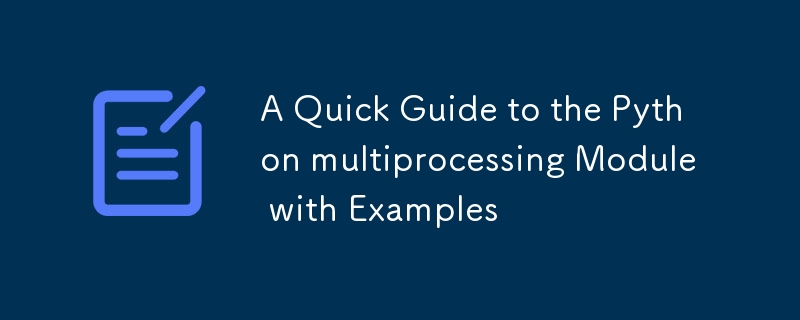Python 多處理模組快速指南及範例

介紹
Python 中的多處理模組可讓您建立和管理進程,使您能夠充分利用機器上的多個處理器。它透過為每個進程使用單獨的記憶體空間來幫助您實現並行執行,這與線程共享相同記憶體空間的線程不同。以下是多處理模組中常用的類別和方法的列表,並附有簡短的範例。
1. 流程
Process 類別是多處理模組的核心,可讓您建立和運行新進程。
from multiprocessing import Process
def print_numbers():
for i in range(5):
print(i)
p = Process(target=print_numbers)
p.start() # Starts a new process
p.join() # Waits for the process to finish
2. 開始()
啟動進程的活動。
p = Process(target=print_numbers) p.start() # Runs the target function in a separate process
3. 加入([超時])
阻塞呼叫程序,直到呼叫 join() 方法的程序終止。您可以選擇指定逾時。
p = Process(target=print_numbers) p.start() p.join(2) # Waits up to 2 seconds for the process to finish
4.is_alive()
如果進程仍在運行,則傳回 True。
p = Process(target=print_numbers) p.start() print(p.is_alive()) # True if the process is still running
5. 當前進程()
傳回表示呼叫程序的目前 Process 物件。
from multiprocessing import current_process
def print_current_process():
print(current_process())
p = Process(target=print_current_process)
p.start() # Prints the current process info
6.active_children()
傳回目前活動的所有 Process 物件的清單。
p1 = Process(target=print_numbers) p2 = Process(target=print_numbers) p1.start() p2.start() print(Process.active_children()) # Lists all active child processes
7. cpu_count()
傳回機器上可用的 CPU 數量。
from multiprocessing import cpu_count print(cpu_count()) # Returns the number of CPUs on the machine
8. 泳池
Pool 物件提供了一種跨多個輸入值並行執行函數的便捷方法。它管理一個工作進程池。
from multiprocessing import Pool
def square(n):
return n * n
with Pool(4) as pool: # Pool with 4 worker processes
result = pool.map(square, [1, 2, 3, 4, 5])
print(result) # [1, 4, 9, 16, 25]
9. 隊列
佇列是一種共享資料結構,允許多個進程透過在它們之間傳遞資料來進行通訊。
from multiprocessing import Process, Queue
def put_data(q):
q.put([1, 2, 3])
def get_data(q):
data = q.get()
print(data)
q = Queue()
p1 = Process(target=put_data, args=(q,))
p2 = Process(target=get_data, args=(q,))
p1.start()
p2.start()
p1.join()
p2.join()
10. 鎖
鎖定確保一次只有一個行程可以存取共享資源。
from multiprocessing import Process, Lock
lock = Lock()
def print_numbers():
with lock:
for i in range(5):
print(i)
p1 = Process(target=print_numbers)
p2 = Process(target=print_numbers)
p1.start()
p2.start()
p1.join()
p2.join()
11. 值和數組
Value 和 Array 物件允許在進程之間共享簡單的資料類型和陣列。
from multiprocessing import Process, Value
def increment(val):
with val.get_lock():
val.value += 1
shared_val = Value('i', 0)
processes = [Process(target=increment, args=(shared_val,)) for _ in range(10)]
for p in processes:
p.start()
for p in processes:
p.join()
print(shared_val.value) # Output will be 10
12. 管道
管道提供兩個進程之間的雙向通訊通道。
from multiprocessing import Process, Pipe
def send_message(conn):
conn.send("Hello from child")
conn.close()
parent_conn, child_conn = Pipe()
p = Process(target=send_message, args=(child_conn,))
p.start()
print(parent_conn.recv()) # Receives data from the child process
p.join()
13. 經理
管理器可讓您建立多個程序可以同時修改的共用對象,例如清單和字典。
from multiprocessing import Process, Manager
def modify_list(shared_list):
shared_list.append("New item")
with Manager() as manager:
shared_list = manager.list([1, 2, 3])
p = Process(target=modify_list, args=(shared_list,))
p.start()
p.join()
print(shared_list) # [1, 2, 3, "New item"]
14. 信號量
信號量允許您控制對資源的訪問,一次只允許一定數量的進程訪問它。
from multiprocessing import Process, Semaphore
import time
sem = Semaphore(2) # Only 2 processes can access the resource
def limited_access():
with sem:
print("Accessing resource")
time.sleep(2)
processes = [Process(target=limited_access) for _ in range(5)]
for p in processes:
p.start()
for p in processes:
p.join()
結論
Python 中的多處理模組旨在充分利用機器上的多個處理器。從使用 Process 建立和管理進程,到使用 Lock 和 Semaphore 控制共享資源,以及透過 Queue 和 Pipe 促進通信,多處理模組對於 Python 應用程式中的平行任務至關重要。
以上是Python 多處理模組快速指南及範例的詳細內容。更多資訊請關注PHP中文網其他相關文章!

熱AI工具

Undresser.AI Undress
人工智慧驅動的應用程序,用於創建逼真的裸體照片

AI Clothes Remover
用於從照片中去除衣服的線上人工智慧工具。

Undress AI Tool
免費脫衣圖片

Clothoff.io
AI脫衣器

Video Face Swap
使用我們完全免費的人工智慧換臉工具,輕鬆在任何影片中換臉!

熱門文章

熱工具

記事本++7.3.1
好用且免費的程式碼編輯器

SublimeText3漢化版
中文版,非常好用

禪工作室 13.0.1
強大的PHP整合開發環境

Dreamweaver CS6
視覺化網頁開發工具

SublimeText3 Mac版
神級程式碼編輯軟體(SublimeText3)
 Python vs.C:申請和用例
Apr 12, 2025 am 12:01 AM
Python vs.C:申請和用例
Apr 12, 2025 am 12:01 AM
Python适合数据科学、Web开发和自动化任务,而C 适用于系统编程、游戏开发和嵌入式系统。Python以简洁和强大的生态系统著称,C 则以高性能和底层控制能力闻名。
 Python:遊戲,Guis等
Apr 13, 2025 am 12:14 AM
Python:遊戲,Guis等
Apr 13, 2025 am 12:14 AM
Python在遊戲和GUI開發中表現出色。 1)遊戲開發使用Pygame,提供繪圖、音頻等功能,適合創建2D遊戲。 2)GUI開發可選擇Tkinter或PyQt,Tkinter簡單易用,PyQt功能豐富,適合專業開發。
 您可以在2小時內學到多少python?
Apr 09, 2025 pm 04:33 PM
您可以在2小時內學到多少python?
Apr 09, 2025 pm 04:33 PM
兩小時內可以學到Python的基礎知識。 1.學習變量和數據類型,2.掌握控制結構如if語句和循環,3.了解函數的定義和使用。這些將幫助你開始編寫簡單的Python程序。
 2小時的Python計劃:一種現實的方法
Apr 11, 2025 am 12:04 AM
2小時的Python計劃:一種現實的方法
Apr 11, 2025 am 12:04 AM
2小時內可以學會Python的基本編程概念和技能。 1.學習變量和數據類型,2.掌握控制流(條件語句和循環),3.理解函數的定義和使用,4.通過簡單示例和代碼片段快速上手Python編程。
 Python與C:學習曲線和易用性
Apr 19, 2025 am 12:20 AM
Python與C:學習曲線和易用性
Apr 19, 2025 am 12:20 AM
Python更易學且易用,C 則更強大但複雜。 1.Python語法簡潔,適合初學者,動態類型和自動內存管理使其易用,但可能導致運行時錯誤。 2.C 提供低級控制和高級特性,適合高性能應用,但學習門檻高,需手動管理內存和類型安全。
 Python和時間:充分利用您的學習時間
Apr 14, 2025 am 12:02 AM
Python和時間:充分利用您的學習時間
Apr 14, 2025 am 12:02 AM
要在有限的時間內最大化學習Python的效率,可以使用Python的datetime、time和schedule模塊。 1.datetime模塊用於記錄和規劃學習時間。 2.time模塊幫助設置學習和休息時間。 3.schedule模塊自動化安排每週學習任務。
 Python:探索其主要應用程序
Apr 10, 2025 am 09:41 AM
Python:探索其主要應用程序
Apr 10, 2025 am 09:41 AM
Python在web開發、數據科學、機器學習、自動化和腳本編寫等領域有廣泛應用。 1)在web開發中,Django和Flask框架簡化了開發過程。 2)數據科學和機器學習領域,NumPy、Pandas、Scikit-learn和TensorFlow庫提供了強大支持。 3)自動化和腳本編寫方面,Python適用於自動化測試和系統管理等任務。
 Python:自動化,腳本和任務管理
Apr 16, 2025 am 12:14 AM
Python:自動化,腳本和任務管理
Apr 16, 2025 am 12:14 AM
Python在自動化、腳本編寫和任務管理中表現出色。 1)自動化:通過標準庫如os、shutil實現文件備份。 2)腳本編寫:使用psutil庫監控系統資源。 3)任務管理:利用schedule庫調度任務。 Python的易用性和豐富庫支持使其在這些領域中成為首選工具。






